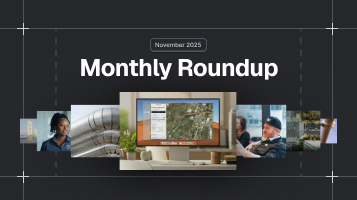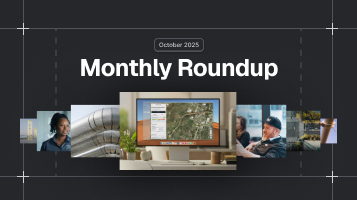How MasTec accelerated utility record research by 7 months for undergrounding project
Written by
.avif)
Chris Garafola
Published on
July 31, 2024


Table of contents
Customer profile
A leading provider of construction, program management, and EPC services, MasTec has 80 years of experience and employs nearly 22,000 skilled professionals. MasTec has been involved in some of the largest, most complex infrastructure projects across the country, including efforts to convert overhead electrical systems to more resilient underground lines.
Project Summary
MasTec currently provides a combination of engineering, easement acquisition, permitting, and construction to a Florida public utility as part of a multi-year effort to replace overhead power lines with underground facilities to increase grid resiliency. Engineers spent months conducting traditional boots-on-the-ground utility records research to gather data on existing utilities ahead of undergrounding projects, only to realize much of it was inaccurate or incomplete and led to constructability issues. In 2024, MasTec partnered with 4M to obtain comprehensive and reliable utility data more quickly. This allowed MasTec to free up their engineers for more productive work, enabling them to complete design and permitting ahead of schedule. MasTec also expects a significant ROI of $250,000 by shifting to 4M as its primary source of utility data.
Key Results & Takeaways
- Accelerated record research by 7 months
- Accelerated design time by 3 months
- Contained $650k in costs
- Expects $250,000 ROI in 2024 by shifting to 4M as the primary source of utility data
- Obtained utility data for 90 projects in 2 months with 4M, vs. 9 months for 80 projects in 2023 using traditional methods
- 4M provided higher data fidelity, projected to reduce constructibility issues
- Projected to complete 2024 design plan three months sooner than in 2023

Straight from the source
Hear what Michael Acosta, P.E., Division VP at MasTec had to say about his experience with 4M's Utility AI Mapping and Analytics Solution.
Challenge
Florida faces a growing number of extreme weather events, from severe thunderstorms to powerful hurricanes and flooding. Rapid population growth of more than 600 residents daily is also straining its infrastructure.
In the midst of high winds and severe weather conditions, overhead power lines are often the first casualties. Extended loss of power means costly downtime for businesses and potentially life-threatening conditions for citizens in hot weather. MasTec works with several major utilities in Florida on programs that will replace overhead wires with more resilient underground lines.
In 2019, MasTec began providing turnkey services — a combination of engineering, easement acquisition, permitting, and construction — to a public utility as part of a large multi-year resiliency program. The purpose of this project is to provide more resilient electric energy to neighborhoods currently served by overhead lines and service drops.
For the next few years, MasTec used traditional methods to gather utility data like as-built drawings — but there was a problem. “The fidelity of that data was not very good,” says Michael Acosta. “That led to constructibility issues once a designed and permitted job reached the construction stage, resulting in more downtime, increased costs, and rework.”
Traditional utility records research also ate up valuable time for their team. “Spending time on research took away from our design and research team’s efforts to meet the current year’s design plans.”
Solution
MasTec leaders wondered if utility AI mapping technology could provide a better, more efficient way to obtain the utility data they needed. “That’s when we found 4M,” Acosta says. But despite his colleague’s confidence that 4M was a viable solution, Acosta was skeptical. “It was hard to fathom how AI pulled this information from so many sources to create a reliable data set. It honestly sounded too good to be true.”
After meeting with the 4M team, Acosta and his colleagues decided to move forward with a pilot demo period. MasTec requested data for a few projects and validated it against the traditional data they had obtained. “When we did the comparison, we decided this is the way to go,” Acosta says. “The 4M data has a much higher fidelity than what we had been getting traditionally. Along with other technology we have incorporated this year, it will help us eliminate a significant portion of constructibility issues.”
Results

With the new ability to request and receive utility data from 4M in short timeframes, MasTec dramatically accelerated its record research. “Last year, it took us nine calendar months to obtain all the existing utility information through traditional methods and bring that data into design environments for 80 projects,” says Acosta. “This year, with 4M, we were able to do these same tasks — for 90 projects — in two months.”
The added efficiency liberated MasTec’s design and permitting team to focus on other, more strategic tasks. This time savings will shorten the timeframe for completing design and permitting projects by 2-3 months compared to last year. “Last year, some of our design work stretched into 2024, but this year, we’ll complete it all before the end of the year,” says Acosta. That allows us to have permits in hand and be ready to launch the construction phase in the new year.”
Once 4M provides the requested utility information, MasTec imports that data into its design environment to prepare conceptual design and permitting submittal drawings. "The 4M utility data is the foundation for a lot of the design," Acosta says. "We use it not just in the conceptual designs and permitting drawings, but also in construction drawings that are prepared, reviewed, and approved by our customers and then built in the field."


MasTec seamlessly incorporates 4M utility data in its design and permitting workflow
Shifting to 4M's utility AI Mapping and Analytics Solution—that remotely delivers instant, comprehensive access to detailed utility information right to your desktop—allowed MasTec to reduce costs significantly in 2024. Factoring in the cost of obtaining the 4M data, the company projects an ROI of about $250,000 through utilizing 4M. “The ability to get projects done quicker and ready for construction sooner pays for 4M on its own,” says Kevin Hotchkiss, director of design and outreach at MasTec. “We’ve never been this far along on a project so soon.”
Going forward, Acosta sees 4M as a key component that will help MasTec meet its client goals and expectations as underground power resilient infrastructure programs continue to scale. “4M is impressive on many levels, including the quality and fidelity of the data, the speed at which we obtain it, and the amazing partnership with the 4M team along the way,” says Acosta. “When you look under the hood, the AI engine and how the 4M solution pulls data from many different sources and presents it in a complete package — that’s impressive, too.”
Straight from the source
What were the biggest challenges you faced on projects like this before 4M?
Michael Acosta: “As our program scaled and we were designing work all over Florida, we found that the traditional methods of securing existing utility data and bringing it into our design environment was taking more and more human resources and was dragging out over many, many months. Those were resources that could be more productively used to engineer and design and draft our projects to meet our customers increasing deliverables.
Quite frankly, another factor is that the traditional methods requesting as-built drawings and receiving them either in hard form or in PDFs, and the fidelity of that data that we were able to secure and bring into our designs was frankly not very good. And so that led to more constructability issues once a designed and permitted job got into construction.
And then this not only then presents downtime and increased cost to our construction team, but also required rework, design, drafting, permitting, which took away from our design and permitting team being able to execute and produce new work to meet the current year's design plan.”
What made you decide to seek a solution like 4M?
Michael Acosta: “We figured there had to be a better way through technology to obtain existing utility information and our director for engineering and the team began to research and see what was out there. And that's how eventually we came to find 4M.”
Did you have any initial doubts about Utility AI technology?
Michael Acosta: “Our programs engineering director brought us the recommendation to incorporate 4M confident that this could be a viable solution. But even myself as a a civil engineer and after reviewing the information and going through the 4M website, I still had my doubts.
It was kind of hard to fathom how AI pulled all this information from all these different sources to give you a reliable data set, right? Reading the material, viewing the website...honestly, it sounded too good to be true. It really did. And it wasn't until we met you and the 4M team with Itzik, with Raz, that we kind of fully understood the breadth, the fidelity of the data, and how short the turnaround time could be to obtain this from 4M versus the traditional methods.”
We still had some doubts and kind of like the last thing that really helped us get across the finish line and initiate the partnership was not just 4M's willingness to come down here and meet with us and walk us through how everything worked, but it was the willingness to engage in a pilot demo period in which, for a few projects, we were able to request the data, bring it in, validate it against the traditional data that we had obtained. And that's when we finally said, 'Man, this is the way to go.' And we felt confident enough, myself and my directors, to make that recommendation to our leadership to execute the agreement and enter into the partnership with 4M at the end of 2023.
Where did 4M help you with a significant breakthrough in your project?
Michael Acosta: “Last year's design plan. So 2023 design and outreach plan. It's what we're building and constructing this year in, in 2024. But for that design plan, the 2023 design plan, it took us nine calendar months to obtain all of the existing utilities information through our traditional methods. Bring that into our design environments for about 80 projects. And this year, so 2024 design and outreach plan, when we first began using 4M, we were able to do these same tasks over a period of just two months for about 90 projects.
So that allowed us to shift our design and permitting resources over to productive work to get the design and the permitting executed sooner. So that's gonna shorten our timeframe on completion by two to three months this year versus what we did last year.
Then the other exciting part, right, is that we're very confident that the data we're getting from 4M has a much higher fidelity than what we had been getting traditionally. And along with other technology that we've incorporated this year, it's gonna help us eliminate a significant portion of constructability issues that we've encountered in the past.”
How did 4M provide value during the early stages of infrastructure development?
Michael Acosta: “We were able to accelerate that record research and bringing all those records into our design environment by, seven calendar months. And that's gonna accelerate our completion of the design time by about three months this year. So last year, some of our design work stretched into 2024. This year, we're gonna get it all completed before the end of 2024.
So that allows us to start permitting early, get permits in hand, and be ready to go much sooner than we were last year. And, you know, speed to market, getting these projects designed, built, energized sooner, provides for a more resilient infrastructure sooner. As we looked at the reduction in time for this research, we have been able to constrain our costs by about $650,000. And then when you look at what the cost of obtaining the 4M data is, we're confident that we have a projected ROI of about $250,000 this year through the utilization of 4M.
How do you see 4M impacting your future infrastructure projects?
Michael Acosta: “I see 4M as being one of the key components that's really gonna help us meet the deliverables, with increased accuracy, shorter timeframes, and meet our customers' expectations as these programs continue to scale. Additionally, I can see where 4M can be incorporated as an important technology partner for us on other turnkey projects or EPC projects and programs as well.”
Sum up 4M’s Utility AI in one word.
Michael Acosta: “There's a lot that comes to mind, honestly. But if it was one word, I'd have to say impressive. On many different levels, right? The quality of the data. The fidelity of the data. I mean, one of the issues we had with traditional methods is it wasn't accurate, but it also didn't detail what the size of the facilities were. The data we're getting from 4M does include that additional information. The speed in which we request it and obtain it is impressive.
Also, the 4M Analytics team, you all have been amazing to work with and willing partners to adjust and help us tailor to our needs. Then, you know, when, when you look under the hood, right? That whole technology and how you pull the information from all these different sources and come up with this bundled package. I mean, that's impressive.”
Recent blog posts

Our Newsletter
Join 7k infrastructure professionals
Get monthly insights on ways to build smarter, faster and safer with Utility AI.






